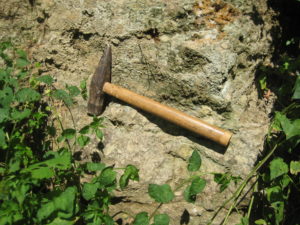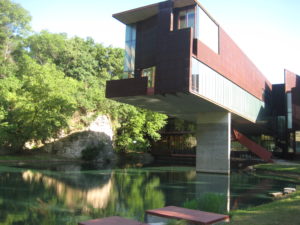The Quarryman’s Hammer
In 1968 I was scoping out an abandoned quarry north of Iowa City for a class field trip. While there I found the remains of an old roughly made steel hammer. The flattened and splayed wide end had obviously struck stone or steel a few million times. The wood handle had mostly rotted away, but the way the tool was tucked back on a little ledge beneath an overhang looked like someone had set it there on purpose, perhaps with the intent of coming back for it. At that time, I was making and collecting hand tools to build our house, so I took it with me, rebuilding the handle from a broken one from a wood splitting maul.

The repaired quarryman’s hammer in a quarry.
About six years later I was building our house and using the chunky hammer to drive stakes for concrete forms, and was visited by “Uncle Bill” Furnish, who was a geology professor at UI since 1953. He fondled the hammer rather covetously, so of course I inquired why. It transpired that he was talking to the UI museum in the MacBride Hall about creating a display focusing on the history of local quarry operations, to be accompanied by a guide to the different formations now exposed in buildings, curbs, tombstones, beer cellars, retaining walls, etc. The fossils exposed would be important to matching back to bedrock sources. He already had a set of the other quarryman’s tools, which he had found over the years, including a set of “feathers,” “spoons,” and “star drills,” but the old hammers had evidently wandered off to other uses when the quarries ceased operation.

Unlike me, the guys who pounded star drills into rock all day became massively built men.
So I gave Bill the hammer. I do not know what became of the quarry/rock display, but I’ve found my hammer now living amongst antiques on display. And the Museum was kind enough in July to loan it back to me for a photo-op. The quarry I originally found it in was mined for much of the stone that went into the Old Capital building on campus; cornerstone date is 1840.
After the Civil War, steam power began to replace manpower in quarrying dimension stone, and the industry shifted to a few large, deep pits in the highest quality stone. Once you go deep you have created a large diameter well and only steam pumps running 24/7 could keep ahead of the inflow of groundwater.
Poured concrete arrived here about 1900 and the large dimension stone quarries gradually shut down except for just a few, which produced the very highest quality facing for buildings, at prices competitive with brick and concrete. Limestone from Salem, Indiana dominates that scene today, and has for a century.

A poor marriage.
With closure, the deep pits immediately flooded and became deep cold lakes. In modern times these are stocked with trout and also serve for recreational scuba diving. The Cedar Valley Quarry is our best known local example.
And what do you do with all the little quarry shelf notches in the hillsides abandoned all along the Iowa River? Some were adsorbed into the widening roadbed of Highway 6. The one below the UI president’s home is still just a little cliff tucked back in the bushes. The one across the river from the UI Memorial Union was maintained for decades as a little decorative landscaping garden, and now has a whole building jammed rather incongruously into it.
Old tools, old trees, and old landscapes all have their stories to tell. And if we pay attention, they help reveal how we evolved to where we are today, for better and for worse, and sometimes offer inspiration for the future.


